大兴安岭地处天山—兴蒙褶皱系晚古生代增生造山带内,是古亚洲洋成矿域与滨太平洋成矿域叠加部位(Wu Fuyuan et al.,2011;潘桂棠等,2016),是我国重要的成矿区带。由于大兴安岭南段在晚中生代发生了大规模的构造岩浆作用,导致大兴安岭地区构造动力学背景较为复杂,前人对大兴安岭地区的中生代岩浆作用进行了广泛而深刻的研究,认为研究区内的白垩纪花岗岩主要在伸展背景下形成,古太平洋板块的俯冲(吴福元等,2003)、蒙古—鄂霍茨克洋闭合造山(Wang Tao et al.,2015;张兴洲等,2012)、板内软流圈地幔上涌(邵济安等,2005)都可作为构造事件发生的诱因,但其成岩地球动力学背景具体如何,仍存在很大争议。
本文通过开展扎鲁特旗地区白垩纪花岗岩的锆石U-Pb年龄、地球化学特征的研究,分析其岩浆成因和物质来源,同时结合区域相关资料,进一步探讨区域上晚中生代花岗岩成因演化及构造背景,为揭示大兴安岭南段所属区域在晚中生代时期的构造运动及岩浆演化规律提供了新依据。
1 地质背景
大兴安岭南段北邻兴安地块,南邻华北克拉通北缘构造带,东为松嫩地块,西接锡林浩特中间陆块(张兴洲等,2006)(图1)。区内出露地层有古生界和中、新生界。主要有上石炭统本巴图组(C2b)灰色粉砂岩、中二叠统大石寨组(P2d)变质安山岩、上二叠统林西组(P3l)变质粉砂岩,中侏罗系统新民组(J2x)砂岩、塔木兰沟组(J2tm)安山岩,上侏罗系统满克头鄂博组(J3m)灰色凝灰岩、玛尼吐组(J3mn)灰色安山岩,下白垩系统白音高老组(K1b)凝灰岩、梅勒图组(K1m)安山岩和第四系。区内岩浆活动强烈而频繁,其中以晚侏罗世及早白垩世火山喷发及侵入活动为主,其次为中二叠世。研究区内中生代火山岩最发育,少量古生代火山岩。大兴安岭中南段处于古亚洲洋陆缘活动带和滨太平洋大陆边缘活动带的叠加复合部位,主要经历了前中生代褶皱基底形成和中、新生代构造—岩浆活化两个不同的地质演化阶段。进入中生代,太平洋板块对亚洲大陆产生强烈的挤压和俯冲,这一区域也较大程度地受到大陆边缘活动的影响,显示出“活化”特征,表现为大规模的断裂及强烈的火山活动,并深刻改造了区内的构造面貌。

图1 大兴安岭南段大地构造位置图(a)(据姚磊等,2017修改)和岩浆岩分布略图(b)
Fig. 1 Tectonic location(a)(modified from Yao Lei et al., 2017&)and distribution map of magmatic rocks(b)of the southern segment of the Great Hinggan Mts.
2 白垩纪花岗岩特征和样品概况
2.1 岩体特征
早白垩世二长花岗岩主要出露于哈德营子幅,呈小岩株状分布(图2),少量为潜火山岩相填充于火山通道处,其侵入晚侏罗世满克头鄂博期、玛尼吐期及早白垩世白音高老期火山岩。早白垩世石英二长斑岩主要出露于测区北部达欧仑郭勒一带,南部巴彦宝力皋—工农、马鞍山及半拉山西侧等地。呈岩株状产出,形态不规则,侵入晚侏罗世满克头鄂博期及玛尼吐期火山岩,晚侏罗世石英二长斑岩等。
2.2 样品描述
本次研究所采集的岩石类型为二长花岗岩,主要出露于研究区北部达欧仑郭勒一带,南部巴彦宝力皋—工农、马鞍山及半拉山西侧等地。地理坐标为:N:45°3′18″;E:120°40′36″。样品采自岩体边部位置,风化面黄褐色,新鲜面呈现灰白色,中粒似斑状花岗结构,块状构造(图3a、b)。主要矿物成分:钾长石,肉红色,半自形板柱状,发育聚片双晶,大小1~2 mm,含量约35%;斜长石,灰白色,自形—半自形,柱状、板状,表面有弱绢云母化,大小1~2 mm,含量35%;石英,灰色,它形,粒状,大小0.2~1 mm,含量25%;黑云母,黑色,片状,大小0.2~0.4 mm,含量5%,具绿泥石化(图3c、d)。

图2 内蒙古扎鲁特旗阿金郭勒地区地质简图
Fig. 2 Simplified geological map of Ajinguole area, Zalute Banner, Inner Mongolia

图3 内蒙古扎鲁特旗阿金郭勒地区二长花岗岩岩石样品(a、b)和正交偏光特征(c、d)照片
Fig. 3 Photographs of rock samples (a, b) and orthogonal polarization characteristics (c, d) of the monzogranites in Ajinguole area, Zalute Banner, Inner Mongolia
(a)、(b) 土黄色块状二长花岗岩;(c)、(d) 呈似斑状结构的花岗岩。Pl—斜长石;Kfs—钾长石;Bt—黑云母;Q—石英
(a),(b) Yellowish massive monzogranites;(c),(d)Porphyritic granites. Pl—Plagioclase;Bt—Biotite;Q—Quartz

图4 内蒙古扎鲁特旗阿金郭勒地区二长花岗岩中锆石CL图像
Fig. 4 Cathodoluminescence (CL) images of zircons in the monzogranites from Ajinguole area, Zalute Banner, Inner Mongolia
3 分析方法
采集的样品于河北省区域地质调查研究所通过常规方法进行破碎和分类。选用表面新鲜且无蚀变的样品对其锆石U-Pb同位素年龄和主、微量元素含量进行了分析。在中国地质大学(北京)地质过程与矿产资源国家重点实验室,我们对所选样品进行了锆石U-Pb同位素年龄测试,期间主要运用中国地质大学刘勇胜等2008年开发的ICPMSDataCal程序和 Ludwig(1999)的Isoplot程序进行数据处理并绘制了相应图件,采用Anderson(2002)的方法对普通铅进行了校正,利用NIST612作为外标计算锆石样品中Pb、U、Th的含量。使用X—荧光光谱仪(XRF)进行了主微量元素分析,相对误差低于5%;使用电感耦合等离子质谱仪(ICP-MS)进行了微量元素分析,相对误差低于10%。主、微量元素的测试分析是在核工业北京地质研究院完成。
4 样品测试
4.1 锆石U-Pb同位素年龄测试
本文对二长花岗岩样品进行了锆石U-Pb定年分析,测试结果见表1。镜下显示,锆石颗粒大多数呈长、短柱状,裂隙较少,晶体自形程度较好,少量颗粒自行程度差,可见裂纹,个别颗粒中含不透明包裹体。在反射光和透射光照射下,锆石颗粒多呈无色,半透明,长宽比3∶1,长度在100~200 μm范围内,振荡环带清晰密集,当属于典型的岩浆成因锆石。锆石CL图像具体见图4。
样品TWT-1选取了30个测试点,经Pb校正,其数据投影大都落在U-Pb谐和线及其附近区域,分布较集中,锆石单个测点n(206Pb)/n(238U)年龄为121~128 Ma,23点获得加权平均值为124±1 Ma,MSWD=0.2;样品TWT-7也选取了30个测试点,经Pb校正,其数据投影大都落在U-Pb谐和线及其附近区域,分布较集中,锆石单个测点n(206Pb)/n(238U)年龄为121~129 Ma,27点获得加权平均值126±1 Ma,MSWD=0.4。
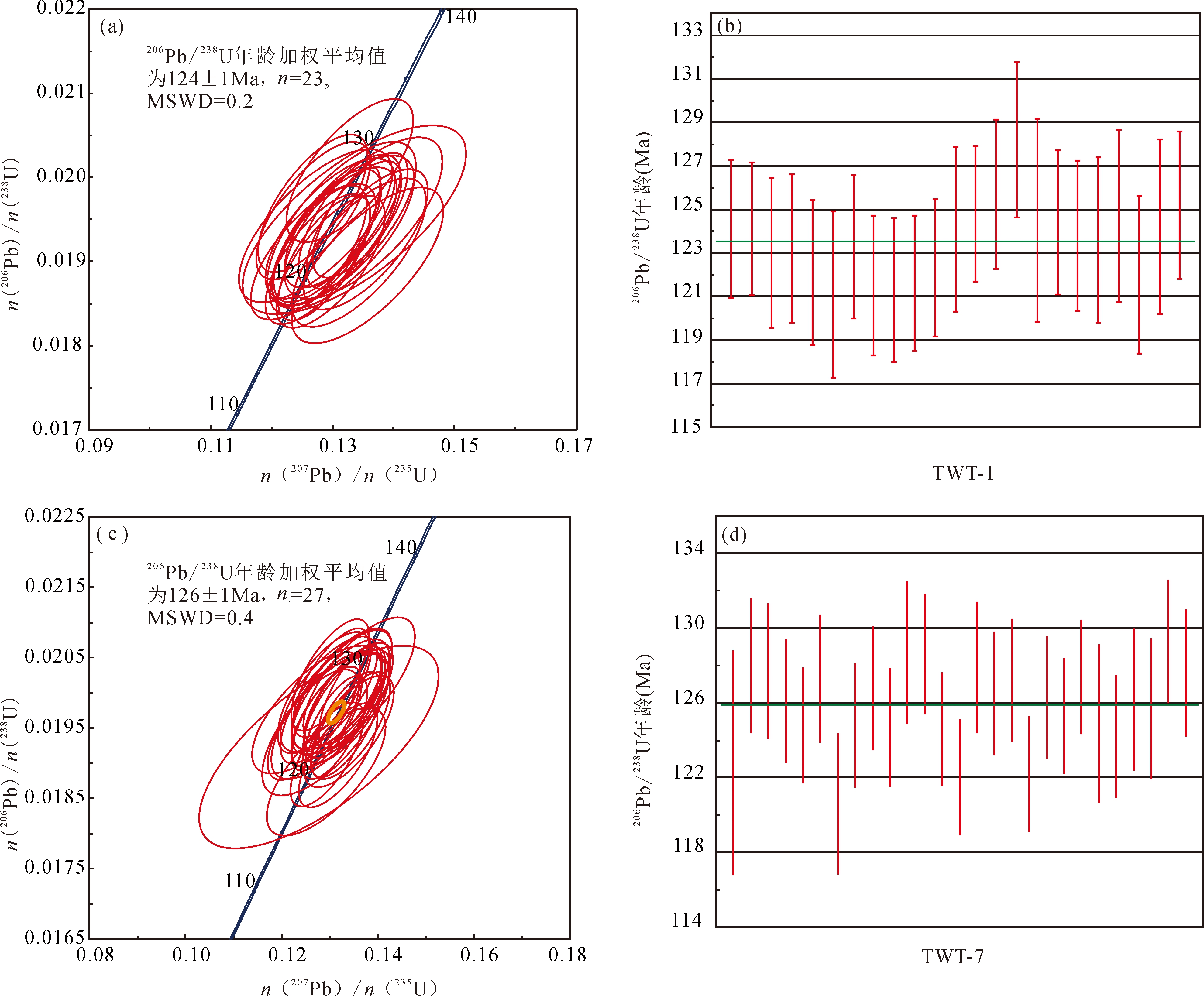
图5 内蒙古扎鲁特旗阿金郭勒地区二长花岗岩样品锆石LA-ICP-MS U-Pb年龄谐和图
n(Fig. 5 Concordia diagrams of LA-ICP-MS zircon U-Pb data of the monzogranites in Ajinguole area, Zalute Banner, Inner Mongolia

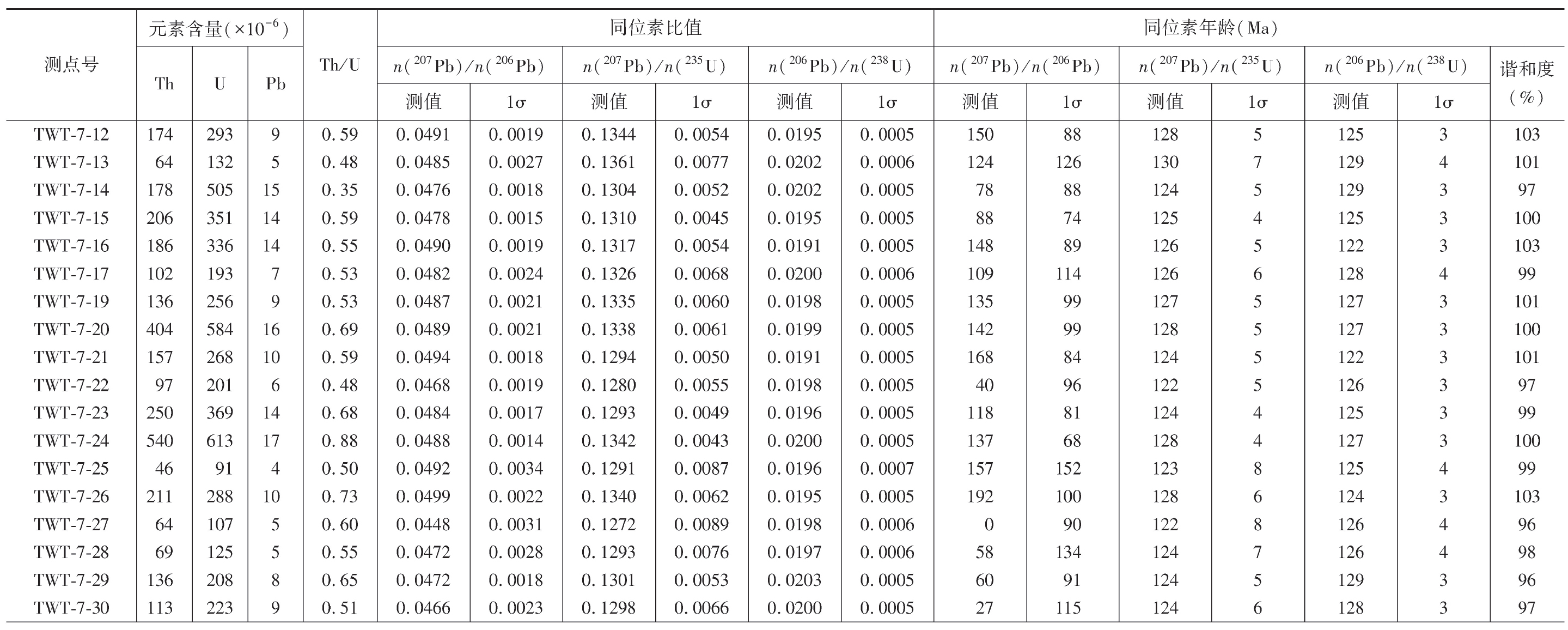
4.2 主、微量元素分析
4.2.1 主量元素
主量元素分析结果如表2所示,岩石SiO2含量为69.45%~73.64%,Na2O和K2O含量分别为3.16%~4.62%、3.78%~4.37%,Na2O/ K2O 值为0.79~1.06;全碱(Na2O+K2O)介于7.15%~9.00%之间;在侵入岩TAS分类图解中,研究区花岗岩数据投影绝大多数落入花岗岩区域,见图6a;在SiO2—K2O图解中,显示样品为高钾钙碱性系列花岗岩类,见图6b。Al2O3含量介于13.54~14.55之间,A/CNK值为1.00~1.25,A/NK值为1.16~1.45,在A/CNK—A/NK 图解中显示属于过铝质岩石,见图6c。
4.2.2 微量元素

图6 内蒙古扎鲁特旗阿金郭勒地区二长花岗岩TAS分类(a)、钙碱性(b)和铝质(c)判别图解
Fig. 6 Total alkalis vs. SiO2 diagram(a), K 2O vs. K2O diagram(b)and A/NK vs. A/CNK diagram(c)for the monzogranites in Ajinguole area, Zalute Banner, Inner Mongolia
由表2可知,所取样品中稀土元素总量(ΣREE)最小值为105.5×10-6,最大值为161.8×10-6,波动较小。稀土元素分配曲线右倾特征明显,轻稀土元素(LREE)值为98.11×10-6~146.1×10-6,较为富集;重稀土元素(HREE)值为7.35×10-6~17.27×10-6,亏损明显。轻稀土元素平均值为126.9×10-6,La/Sm平均值为8.57,分馏较好;重稀土元素平均值为11.89×10-6,(La/Yb)N值为10.27~25.82,LREE/HREE值为8.27~13.35,δEu值为0.13~0.24,岩石负Eu异常较强烈。在岩石微量元素原始地幔标准化蛛网图(图7a)中,可见K、Ba、Rb等大离子亲石元素以及Zr、Th、U、Hf等不相容元素呈现富集状态,P、Ti、Nb、Ta等高场强元素则亏损严重,这意味着花岗岩浆可能发生了高度分异。
5 讨论
5.1 成岩年代
本文选取扎鲁特旗岩体中二长花岗岩进行锆石U-Pb测年,获得的年龄为(124±1) Ma,n=23,MSWD=0.2和(126±1) Ma,n=27,MSWD=0.4,分析点多位于锆石边部或幔部结晶环带部位,数据点大都位于 U-Pb 谐和线附近,分部较集中,这些测试数据可以代表锆石的结晶年龄,也反映出所属岩体的侵位年龄。测试结果显示,研究区花岗岩形成于早白垩世。这一结果与大兴安岭中南段晚中生代花岗岩主要形成于早白垩世(142~124 Ma)(杨奇荻等,2014)相一致,与区域上115~145 Ma中国东北地区岩浆活动剧烈期相吻合(Wu Fuyuan et al.,2007;欧阳荷根,2013)。
5.2 岩石成因
自Chappell和White(1974)提出了I型和S型花岗岩成因分类后,80年代相继出现了多达20种或更多的成因分类,其中最流行的是I、S、M、A型花岗岩成因分类。扎鲁特旗二长花岗岩主量元素显示高硅(SiO2:69.45%~73.64%)、高碱(Na2O+K2O:7.15%~9.00%)和弱过铝质(A/CNK:1.00~1.25)的特点,同时具有低磷(P2O5:0.01~0.31)、低镁(MgO:0.46~1.07)、低钙(CaO:0.78~1.03)的特征。在微量元素中,扎鲁特旗二长花岗岩具有较明显的负铕异常(δEu值为0.13~0.24),富集Ba、Rb等大离子亲石元素,相对亏损Nb、Ta等高场强元素。这些特征使得扎鲁特旗二长花岗岩成因类型难以确定,既有I型花岗岩富钠的特点,也有A型花岗岩富硅、富钾、贫磷的特征,同时又与高硅、过铝质的S型花岗岩相似。
角闪石、堇青石、碱性的镁铁矿物的出现是判断I、S、A 型三类花岗岩的有效标志(吴福元等,2007)。在扎鲁特旗二长花岗岩中并没有观察到有钠闪石—钠铁闪石、霓石—霓辉石等典型的碱性暗色矿物(Chappell,1999),而通过计算过碱指数(AI),扎鲁特旗二长花岗岩的过碱指数(AI)介于0.69~0.86之间,基本低于A型花岗岩的AI值(>0.85)(Whalen et al.,1987)。在FeO*/MgO—(Zr+Nb+Ce+Y)(图8a)和(K2O+Na2O)/CaO—(Zr+Nb+Ce+Y)(图8b)的判别图解上,扎鲁特旗二长花岗岩的数据投点基本落入非A型花岗岩类的范围中,由此可见扎鲁特旗二长花岗岩应属于分异的I型或S型花岗岩。分异的I型或者S型花岗岩往往具有相似的主量元素特征和矿物组合,其成因类型难以准确识别(吴福元等,2007)。但是Pichavant 等(1992)指出,磷在强过铝质的熔体中,具有高的溶解度,并随着分异程度的增加含量升高;而在偏铝质或弱过铝质的熔体中,具有很低的溶解度,且随分异程度的增加含量降低。扎鲁特旗二长花岗岩具有很低的P2O5含量,且随着SiO2含量增加而降低(图8c);同时其Th含量较高,并与Rb含量呈正相关(图8d),显示了I型花岗岩的特点。虽然其A/CNK值为1.00~1.25,但是A/CNK>1(或1.1)者不一定是S型花岗岩(邓晋福等,2015a;2015b)。在矿物学上,扎鲁特旗二长花岗岩中也未观察到电气石、堇青石、石榴子石、白云母等典型S型花岗岩矿物。因此,本文认为扎鲁特旗二长花岗岩为高分异I型花岗岩。在该区域,侏罗纪时期的花岗岩发育以板内I型、I—A型花岗岩为主,是受岛弧或后碰撞环境影响形成的。到了白垩纪时期,受到岩浆活动的剧烈影响,花岗岩岩性发生较大变化,由高钾钙碱性向碱性、镁质向铁质、I型花岗岩向高分异I型或A型花岗岩演变(王玮,2018)。
5.3 构造背景
大兴安岭南段是研究东北亚地区中生代构造岩浆演化的重要地区之一,在其漫长的形成演化过程中,先是西伯利亚板块同华北板块发生碰撞,接着古亚洲洋闭合并向古太平洋体制转换,期间还可能遭受了蒙古—鄂霍次克洋构造动力学背景的控制(Jiang Sihong et al.,2016;李锦轶等,2007)。大兴安岭南段及其邻区在晚中生代时期岩浆—构造活动十分频繁,早白垩世(135 Ma)更为集中,该特征与中国东部地区的岩浆演化时序大体相同(Wu Fuyuan et al.,2011;Zhou Zhenhua et al.,2012;江思宏等,2011)。早白垩世时期,不仅A型花岗岩在该区域大量出露,而且包括研究区在内的I型花岗岩也广泛发育,呈现出伸展的构造环境,甘珠尔庙变质核杂岩等伸展背景产物的存在也对此提供了有力支撑(张履桥等,1998)。在微量元素构造环境判别图上(图9),扎鲁特旗二长花岗岩样品点落在了后碰撞区域,表明扎鲁特旗二长花岗岩可能产出于后碰撞伸展环境。
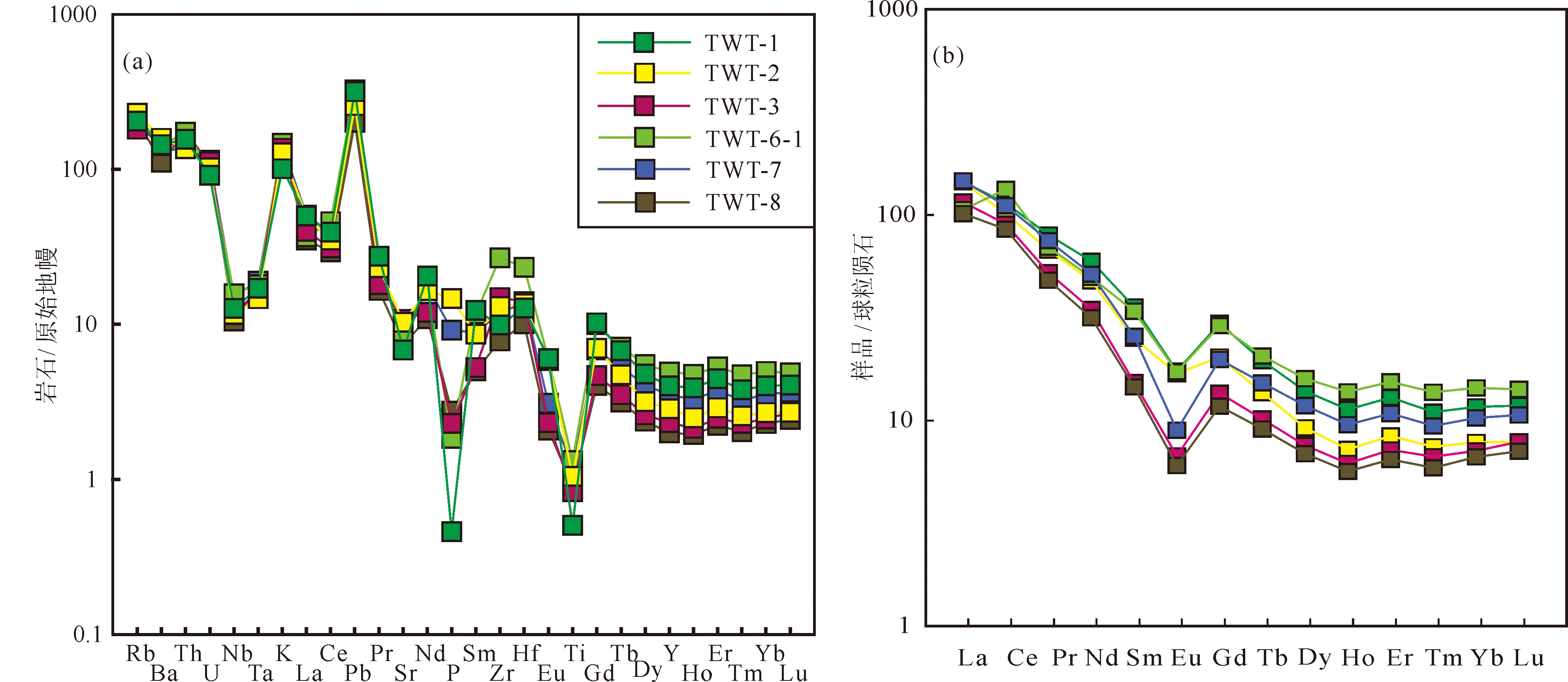
图7 内蒙古扎鲁特旗阿金郭勒地区二长花岗岩微量元素原始地幔标准化蛛网图(a)和稀土元素球粒陨石标准化分布模式图(b)(标准化值据Sun and McDonough,1989)
Fig. 7 Primitive mantle-normalized diagram(a)and chondrite-normalized REE patterns(b)of the monzogranites in Ajinguole area, Zalute Banner, Inner Mongolia(normalization values after Sun and McDonough, 1989)
表2 内蒙古扎鲁特旗阿金郭勒地区二长花岗岩主量元素(%)、微量(×10-6)和稀土元素(×10-6)分析数据
Table 2 Analysis data of major elements(%),trace elements and rare earth elements(×10-6) of the monzogranites in Ajinguole area, Zalute Banner, Inner Mongolia
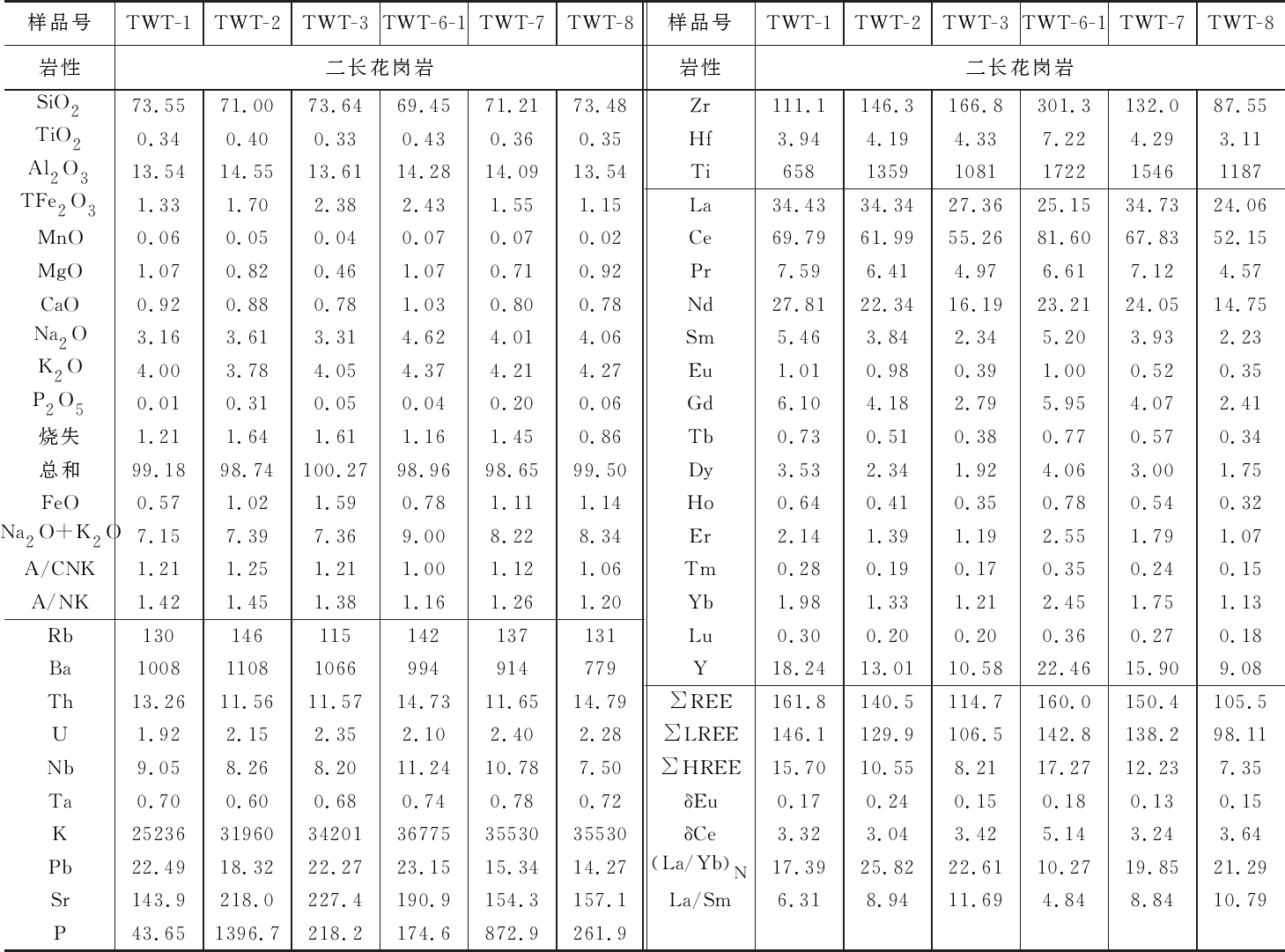
样品号TWT-1TWT-2TWT-3TWT-6-1TWT-7TWT-8岩性二长花岗岩SiO273.55 71.00 73.64 69.45 71.21 73.48 TiO20.34 0.40 0.33 0.43 0.36 0.35 Al2O313.54 14.55 13.61 14.28 14.09 13.54 TFe2O31.33 1.70 2.38 2.43 1.55 1.15 MnO0.06 0.05 0.04 0.07 0.07 0.02 MgO1.07 0.82 0.46 1.07 0.71 0.92 CaO0.92 0.88 0.78 1.03 0.80 0.78 Na2O3.16 3.61 3.31 4.62 4.01 4.06 K2O4.00 3.78 4.05 4.37 4.21 4.27 P2O50.01 0.31 0.05 0.04 0.20 0.06 烧失1.21 1.64 1.61 1.16 1.45 0.86 总和99.18 98.74 100.27 98.96 98.65 99.50 FeO0.57 1.02 1.59 0.78 1.11 1.14 Na2O+K2O7.15 7.39 7.36 9.00 8.22 8.34 A/CNK1.21 1.25 1.21 1.00 1.12 1.06 A/NK1.42 1.45 1.38 1.16 1.26 1.20 Rb130 146 115 142 137 131 Ba1008 1108 1066 994 914 779 Th13.26 11.56 11.57 14.73 11.65 14.79 U1.92 2.15 2.35 2.10 2.40 2.28 Nb9.05 8.26 8.20 11.24 10.78 7.50 Ta0.70 0.60 0.68 0.74 0.78 0.72 K25236 31960 34201 36775 35530 35530 Pb22.49 18.32 22.27 23.15 15.34 14.27 Sr143.9 218.0 227.4 190.9 154.3 157.1 P43.65 1396.7 218.2 174.6 872.9 261.9 样品号TWT-1TWT-2TWT-3TWT-6-1TWT-7TWT-8岩性二长花岗岩Zr111.1 146.3 166.8 301.3 132.0 87.55 Hf3.94 4.19 4.33 7.22 4.29 3.11 Ti658 1359 1081 1722 1546 1187 La34.43 34.34 27.36 25.15 34.73 24.06 Ce69.79 61.99 55.26 81.60 67.83 52.15 Pr7.59 6.41 4.97 6.61 7.12 4.57 Nd27.81 22.34 16.19 23.21 24.05 14.75 Sm5.46 3.84 2.34 5.20 3.93 2.23 Eu1.01 0.98 0.39 1.00 0.52 0.35 Gd6.10 4.18 2.79 5.95 4.07 2.41 Tb0.73 0.51 0.38 0.77 0.57 0.34 Dy3.53 2.34 1.92 4.06 3.00 1.75 Ho0.64 0.41 0.35 0.78 0.54 0.32 Er2.14 1.39 1.19 2.55 1.79 1.07 Tm0.28 0.19 0.17 0.35 0.24 0.15 Yb1.98 1.33 1.21 2.45 1.75 1.13 Lu0.30 0.20 0.20 0.36 0.27 0.18 Y18.24 13.01 10.58 22.46 15.90 9.08 ∑REE161.8 140.5 114.7 160.0 150.4 105.5 ∑LREE146.1 129.9 106.5 142.8 138.2 98.11 ∑HREE15.70 10.55 8.21 17.27 12.23 7.35 δEu0.17 0.24 0.15 0.18 0.13 0.15 δCe3.32 3.04 3.42 5.14 3.24 3.64 (La/Yb)N17.39 25.82 22.61 10.27 19.85 21.29 La/Sm6.31 8.94 11.69 4.84 8.84 10.79

图8 内蒙古扎鲁特旗阿金郭勒地区二长花岗岩(Zr+Nb+Ce+Y)—(FeO*/MgO)图解(a)、(Zr+Nb+Ce+Y)—(Na2O+K2O)/CaO图解(b)图解(据Whalen et al.,1987)、SiO2—P2O5图解(c)和Rb—Th图解(d)
Fig. 8 (Zr+Nb+Ce+Y) vs. (FeO*/MgO) diagram(a)、(Zr+Nb+Ce+Y) vs. (Na2O+K2O)/CaO diagram(b)(after Whalen et al., 1987)、SiO2 vs. P2O5 diagram(c)and Rb vs. Th(d)of the monzogranites in Ajinguole area, Zalute Banner, Inner Mongolia
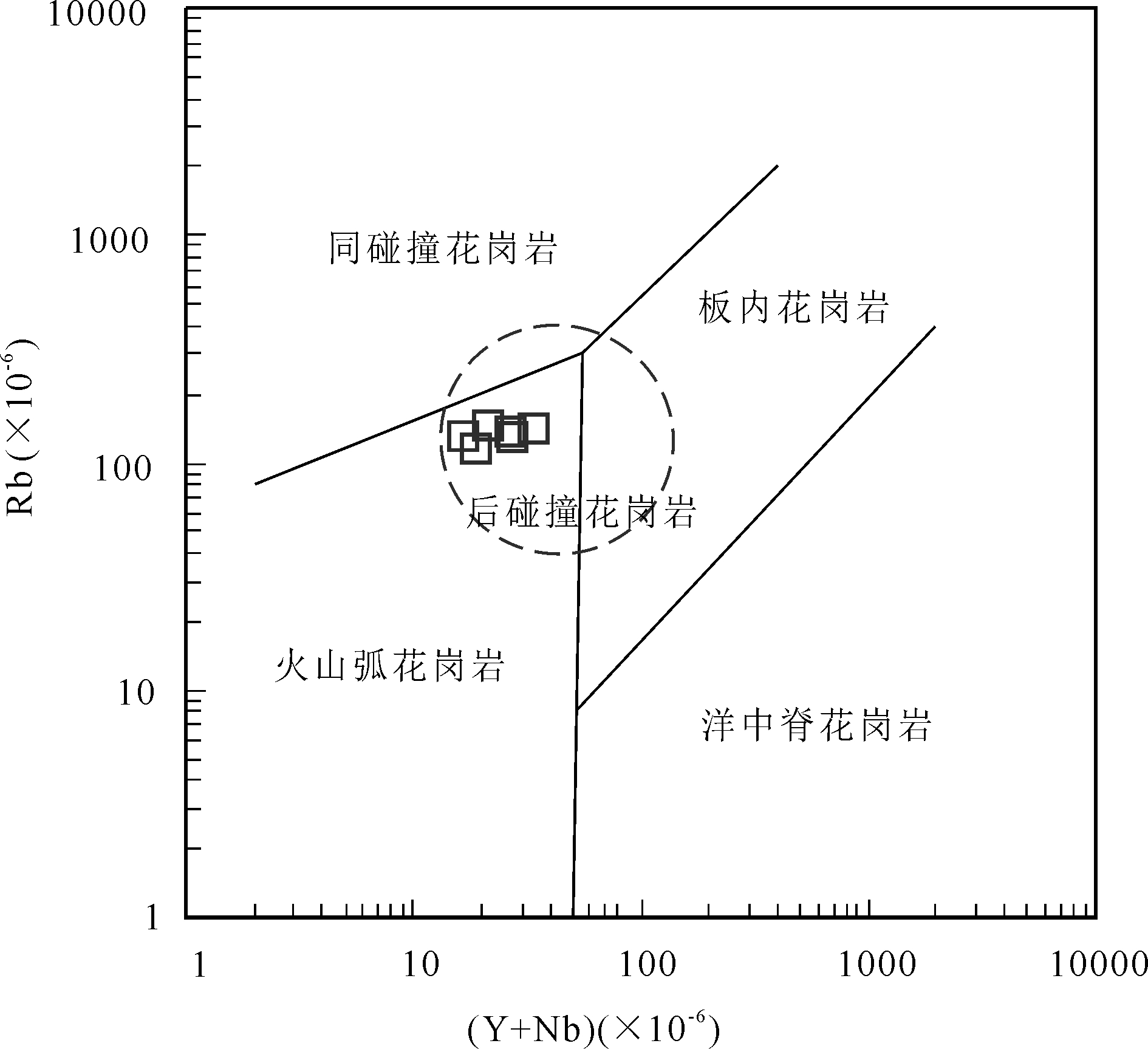
图9 内蒙古扎鲁特旗阿金郭勒地区二长花岗岩微量元素花岗岩类构造环境判别图解(底图据Pearce,1996)
Fig. 9 Discrimination diagrams of tectonic setting of trace element granites of the monzogranites in Ajinguole area, Zalute Banner, Inner Mongolia(after Pearce, 1996)
但是,关于引起这种大规模伸展构造环境的动力学背景尚存争议,主要为: ① 受其东侧太平洋板块俯冲影响(孙卫东等,2007;肖庆辉等,2010);② 与蒙古—鄂霍次克洋的俯冲作用有关(Chen Bin et al.,2000;李竞妍等,2014;唐杰等,2018)。李锦轶等(2004)认为,中国东北部地区及相邻大陆直至白垩世中晚期乃至古近纪初期,才遭受古太平洋俯冲作用影响;张旗(2013)则表示,太平洋向西俯冲的时间段只有两个,即125~110 Ma和43~0 Ma,而在此期间,这一事件对中国东部中生代岩浆活动的影响有限。本文研究区花岗岩的侵位年龄为早白垩世,因此排除了受太平洋板块俯冲影响的因素。而在该时期,蒙古—鄂霍茨克造山带碰撞造山作用已经结束,开始转变为碰撞后的拉张构造环境(Wang Tao et al.,2011),因此认为大兴安岭南部扎鲁特旗地区的伸展作用应主要与蒙古—鄂霍茨克造山带的伸展垮塌作用有关。
6 结论
(1)获得了大兴安岭南段扎鲁特旗地区二长花岗岩形成年龄为124±1 Ma(n=23,MSWD=0.2)和126±1 Ma(n=27,MSWD=0.4),认为岩石形成时代为早白垩世。
(2)二长花岗岩地球化学特征显示具有高钾钙碱性、过铝质特征,属高分异的I型花岗岩。
(3)扎鲁特旗地区岩体研究结果显示该区域的伸展作用应主要与蒙古—鄂霍茨克造山带的伸展垮塌作用有关。
致谢:本次研究的实验测试分析得到了中国地质大学(北京)地质过程与矿产资源国家重点实验室的协助;三位专家审阅论文并提出了宝贵的修改意见,在此一并感谢。
(The literature whose publishing year followed by a “&” is in Chinese with English abstract; The literature whose publishing year followed by a “#” is in Chinese without English abstract)
邓晋福,刘翠,冯艳芳,肖庆辉,狄永军,苏尚国,赵国春,段培新,戴蒙. 2015a. 关于火成岩常用图解的正确使用:讨论与建议. 地质论评,61(4):717~734.
邓晋福,冯艳芳,狄永军,刘翠,肖庆辉,苏尚国,赵国春,孟斐,马帅,姚图. 2015b. 岩浆弧火成岩构造组合与洋陆转换. 地质论评,61(3):473~484.
江思宏,聂凤军,刘翼飞,侯万荣,白大明,刘妍,梁清玲. 2011. 内蒙古孟恩陶勒盖银多金属矿床及其附近侵入岩的年代学. 吉林大学学报(地球科学版),41(6):1755~1769.
李锦轶,莫申国,和政军,孙桂华,陈文. 2004. 大兴安岭北段地壳左行走滑运动的时代及其对中国东北及邻区中生代以来地壳构造演化重建的制约. 地学前缘,11(3):157~168.
李锦轶,高立明,孙桂华,李亚萍,王彦斌. 2007. 内蒙古东部双井子中三叠世同碰撞壳源花岗岩的确定及其对西伯利亚与中朝古板块碰撞时限的约束. 岩石学报,23(3):565~582.
李竞妍,郭锋,李超文,李红霞,赵亮. 2014. 东北地区晚古生代—中生代I型和 A型花岗岩Nd同位素变化趋势及其构造意义. 岩石学报,30(7):1995~2008.
刘孜,黄行凯,祝新友,蒋斌斌,徐巧,魏巍,张志强,彭青松. 2017. 内蒙古小井子北铜钼矿区黑云母二长花岗岩年代学、地球化学特征及地质意义. 矿产勘查,8(6):997~1009.
欧阳荷根. 2013. 大兴安岭南段拜仁达坝—维拉斯托银多金属矿床成矿作用及动力学背景. 导师:毛景文. 北京:中国地质大学(北京)博士学位论文:1~192.
潘桂棠,陆松年,肖庆辉,张克信,尹福光,郝国杰,骆满生,任飞,袁四化. 2016. 中国大地构造阶段划分和演化. 地学前缘,23(6):1~23.
邵济安,张履桥,肖庆辉,李晓波. 2005. 中生代大兴安岭的隆起——一种可能的陆内造山机制. 岩石学报,21(3): 789~794.
孙卫东,凌明星,汪方跃,丁兴,胡艳华,周继彬,杨晓勇. 2007. 太平洋板块俯冲与中国东部中生代地质事件. 矿物岩石地球化学通报,27(3): 218~225.
唐杰,许文良,王枫,葛文春. 2018. 古太平洋板块在欧亚大陆下的俯冲历史:东北亚陆缘中生代—古近纪岩浆记录. 中国科学:地球科学,48(5):549~583.
王玮. 2018. 大兴安岭南段碧流台地区早白垩世花岗岩年代学、地球化学及其构造成矿意义. 导师:张招崇. 北京:中国地质大学(北京)硕士学位论文:35~42.
吴福元,葛文春,孙德有,郭春丽. 2003. 中国东部岩石圈减薄研究中的几个问题. 地学前缘,10(3):51~60.
吴福元,李献华,杨进辉,郑永飞. 2007. 花岗岩成因研究的若干问题. 岩石学报,23(6):1217~1238.
肖庆辉,刘勇,冯艳芳,邱瑞照,张昱. 2010. 中国东部中生代岩石圈演化与太平洋板块俯冲消减关系的讨论. 中国地质,37(4):1092~1101.
杨奇荻,郭磊,王涛,曾涛,张磊,童英,史兴俊,张建军. 2014. 大兴安岭中南段甘珠尔庙地区晚中生代两期花岗岩的时代、成因、物源及其构造背景. 岩石学报,30(7):1961~1981.
姚磊,吕志成,叶天竺,庞振山,贾宏翔,张志辉,吴云峰,李睿华. 2017. 大兴安岭南段内蒙古白音查干Sn多金属矿床石英斑岩的锆石U-Pb年龄、地球化学和Nd—Hf同位素特征及地质意义. 岩石学报,33(10):3183~3199.
张履桥,邵济安,郑广瑞. 1998. 内蒙古甘珠尔庙变质核杂岩. 地质科学,33(2):140~146.
张旗. 2013. 中国东部中生代岩浆活动与太平洋板块向西俯冲有关吗? 岩石矿物学杂志,32(1):113~128.
张兴洲,杨宝俊,吴福元,刘国兴. 2006. 中国兴蒙—吉黑地区岩石圈结构基本特征. 中国地质,33(4):816~823.
张兴洲,马玉霞,迟效国,张凤旭,孙跃武,郭冶,曾振. 2012. 东北及内蒙古东部地区显生宙构造演化的有关问题. 吉林大学学报:地球科学版,42:(5)1269~1285.
Andersen T. 2002.Correction of common lead in U-Pb analyses that do not report 204Pb. Chemical Geology, 192: 59~79.
Chappell B W and White A J R. 1974. Two contrasting granite types. Pacific Geology, 8: 74~173.
Chappell B W. 1999.Aluminium saturation in I- and S-type granites and the characterization of fractionated haplogranites.Lithos, 46(3): 535~551.
Chen Bin, Jahn Bor-ming, Wilde S, Xu Bei. 2000. Two contrasting Paleozoic magmatic belts in northern Inner Mongolia, China:petrogenesis and tectonic implications. Tectonophysics, 328: 157~182.
Deng Jinfu, Liu Cui, Feng Yanfang, Xiao Qinhui, Di Yongjun, Su Shangguo, Zhao Guochun, Duan Peixin, Dai Meng. 1999&. On the correct application in the common igneous petrological diagrams:discussion and sugestion. Geological Review, 61(4): 717~734.
Jiang Sihong, Nie Fengjun, Liu Yifei, Hou Wanrong, Bai Daming, Liu Yan, Liang Qingling. 2011&. Geochronology of intrusive rocks occurring in and around the Mengentaolegai silver—polymetallic deposit, Inner Mongolia. Journal of Jilin University (Earth Science Edition), 41(6): 1755~1769.
Jiang Sihong, Bagas Leon, Hu Peng, Han Ning, Chen Chunliang, Liu Yuan, Kang Huan. 2016. Zircon U-Pb ages and Sr—Nd—Hf isotopes of the highly fractionated granite with tetrad REE patterns in the Shamai tungsten deposit in eastern Inner Mongolia, China:Implications for the timing of mineralization and ore genesis. Lithos, 261: 322~339.
Kessel R, Schmidt M W, Ulmer P, Pettke T. 2005. Trace element signature of subduction-zone fluids, melts and supercritical liquids at 120~180 km depth. Nature, 437: 724~727.
Li Jinyi, Mo Shenguo, He Zhengjun, Sun Guihua, Chen Wen. 2004&. The timing of crustal sinistral strike-slip in the northern Great Khing’an Ranges and its constraint on reconstruction of the crustal tectonic evolution of NE China and adjacent areas since the Mesozoic. Earth Science Frontiers, 11(3): 157~168.
Li Jinyi, Gao Liming, Sun Guihua, Li Yaping and Wang Yanbin. 2007&. Shuangjingzi middle Triassic syn-collisional crust-derived granite in the east Inner Mongolia and its constraint on the timing of collision between Siberian and Sino—Korean paleo-plates. Acta Petrologica Sinica, 23(3): 565~582.
Li Jingyan, Guo Feng, Li Chaowen, Li Hongxia and Zhao Liang. 2014&. Neodymium isotopic variations of Late Paleozoic to Mesozoic I- and A- type granitiods in NE China:Implications for tectonic evolution. Acta Petrologica Sinica, 30(7): 1995~2008.
Liu Yongsheng, Hu Zhaochu, Gao Shan, Detlef Günther, Xu Juan, Gao Changgui, Chen Haihong. 2008. In situ analysis of major and trace elements of anhydrous minerals by LA-ICP-MS without applying an internal standard. Chemical Geology, 257: 34~43.
Liu Zi, Huang Xingkai, Zhu Xinyou, Jiang Binbin, Zhang Zhiqiang, Peng Qingsong. 2017&. Chronology of U-Pb zircon and geochemistry of the biotite monzogranite and its geological implication of the north Xiaojingzi copper—molybdenum deposit in Inner mongolia. Mineral Exploration, 8(6): 997~1009.
Ludwig K R. 1999. UsingIsoplot/Ex Version 2, a geochronological toolkit for Microsoft excel. Berkeley: Berkeley Geochronological Centre Special Publications: 1~47.
Moriguti Takuya, Nakamura Eizo. 1998. Across-arc variation of Li isotopes in lavas and implications for crust/mantle recycling at subduction zones. Earth and planetary science letters, 163: 167~174.
Ouyang Hegen. 2013&. Metallogenesis and dynamics background of Bayrendaba—Willastow silver polymetallic deposit in the southern section of Da Hinggan Mountains. Dissertation Supervisor:Prof. Mao Jingwen. Beijing:A Dissertation Submitted to China University of Geosciences (Beijing) for Doctor Degree: 1~192.
Pearce J A. 1996. Sources and settings of granitic rocks. Episodes, 19: 120~125.
Pearce J. 1982. Trace element characteristics of lavas from destructive plate boundaries. Andesites, 8: 525~548.
Pichavant M, Montel J M and Richard L R. 1992. Apatite solubility in peraluminous liquids:Experimental data and an extension of the Harrison—Watson model. Geochimica et Cosmochimica Acta, 56(10): 3855~3861.
Shao Ji’an, Zhang ![]() Xiao Qinghui, Li Xiaobo. 2005&. Rising of Da Hinggan Mts in Mesozoic: A possible mechanism of intracontinental orogeny. Acta Petrologica Sinica, 21(3): 789~794.
Xiao Qinghui, Li Xiaobo. 2005&. Rising of Da Hinggan Mts in Mesozoic: A possible mechanism of intracontinental orogeny. Acta Petrologica Sinica, 21(3): 789~794.
Sun S S, McDonough W F. 1989. Chemical and isotopic systematics of oceanic basalts: implications for mantle composition and processes. Geological Society, London, Special Publications, 42: 313~345.
Sun Weidong, Ling Mingxing, Wang Fangyue, Ding Xing, Hu Yanhua, Zhou Jibin, Yang Xiaoyong. 2007&. Pacific plate subduction and mesozoic geological event in eastern China. Bulletin of Mineralogy, Petrology and Geochemistry, 27(3):218~225.
Tang Jie, Xu Wenliang, Wang Feng, Ge Wenchun. 2018&. Subduction history of the Paleo-Pacific slab beneath Eurasian continent: Mesozoic—Paleogene magmaticrecords in Northeast Asia. Science China Earth Sciences, 61(5): 527~559.
Tatsumi Y, Hamilton D L, Nesbitt R W. 1986. Chemical characteristics of fluid phase released from a subducted lithosphere and origin of arc magmas:evidence from high-pressure experiments and natural rocks. Journal of Volcanology and Geothermal Research, 29: 293~309.
Wang Tao, Guo Lei, Zhang Lei, Yang Qidi, Zhang Jianjun, Tong Ying, Ye Ke. 2015. Timing and evolution of Jurassic—Cretaceous granitoid magmatisms in the Mongol—Okhotsk belt and adjacent areas, NE Asia:Implications for transition from contractional crustal thickening to extensional thinning and geodynamic settings. Journal of Asian Earth Sciences, 97: 365~392.
Wang Tao,Zheng Yadong, Zhang Jinjiang, Zeng Lingsen, Donskaya Tatiana, Guo Lei, Li Jianbo. 2011. Pattern and kinematic polarity of late Mesozoic extension in continental NE Asia: Perspectives from metamorphic core complexes. Tectonics, 30(6): doi: 10. 1029 /2011TC002896.
Wang Wei. 2018&. Geochronology, geochemistry and tectonic significance of the Early Cretaceous granites in the Biliutai area of southern Da Hinggan Moutains. Dissertation Supervisor: Prof. Zhang Zhaochong. Beijing: A Dissertation Submitted to China University of Geosciences (Beijing) for Master Degree: 1~49.
Whalen J B, Currie K L, Chappell B W. 1987. A-type granites: Geochemical characteristics, discrimination andpetrogenesis. Contributions to Mineralogy and Petrology, 95(4): 407~ 419.
Wu Fuyuan, Ge Wenchun, Sun Deyou, Guo Chunli. 2003&. Discussions on the lithospheric thinning in eastern China. Earth Science Frontiers, 10(3): 51~60.
Wu Fuyuan, Li Xianhua, Yang Jinhui, Zheng Yongfei. 2007&. Discussions on the petrogenesis of granites. Acta Petrologica Sinica, 23(6): 1217~1238.
Wu Fuyuan, Zhao Guochun, Sun Deyou, Wilde Simon A, Yang Jinhui. 2007. The Hulan Group: Its role in the evolution of the Central Asian Orogenic Belt of NE China. Journal of Asian Earth Sciences, 30: 542~556.
Wu Fuyuan, Sun Deyou, Ge Wenchun, Zhang Yanbin, Grant Matthew L, Wilde Simon A, Jahn Bor-ming. 2011. Geochronology of the Phanerozoic granitoids in northeastern China. Journal of Asian Earth Sciences, 41: 1~30.
Xiao Qinghui, Liu Yong, Feng Yanfang, Qiu Ruizhao, Zhang Yu. 2010&. A preliminary in study of the relationship between Mesozoic lithosphere evolution eastern China and the subduction of the Pacific plate. Geology in China, 37(4): 1092~1101.
Yang Qidi, Guo Lei, Wang Tao, Zeng Tao, Zhang Lei, Tong Ying, Shi Xingjun and Zhang Jianjun. 2014&. Geochronology, origin, sources and tectonic settings of Late Mesozoic two-stage granites in the Ganzhuermiao region, central and southern Da Hinggan Range, NE China. Acta Petrologica Sinica, 30(7): 1961~1981.
Yao Lei, ![]() Zhicheng, Ye Tianzhu, Pang Zhenshan, Jia Hongxiang, Zhang Zhihui, Wu Yunfeng, Li Ruihua. 2017&. Zircon U-Pb age, geochemical and Nd—Hf isotopic characteristics of quartz porphyry in the Baiyinchagan Sn polymetallic deposit, Inner Mongolia, southern Great Xing, an Range, China. Acta Petrologica Sinica, 33(10): 3183~3199.
Zhicheng, Ye Tianzhu, Pang Zhenshan, Jia Hongxiang, Zhang Zhihui, Wu Yunfeng, Li Ruihua. 2017&. Zircon U-Pb age, geochemical and Nd—Hf isotopic characteristics of quartz porphyry in the Baiyinchagan Sn polymetallic deposit, Inner Mongolia, southern Great Xing, an Range, China. Acta Petrologica Sinica, 33(10): 3183~3199.
Zhang ![]() Shao Ji’an, Zheng Guangrui. 1998&. Metamorphic core complex in Ganzhuermiao, Inner Mongolia. Chinese Journal of Geology, 33(2): 140~146.
Shao Ji’an, Zheng Guangrui. 1998&. Metamorphic core complex in Ganzhuermiao, Inner Mongolia. Chinese Journal of Geology, 33(2): 140~146.
Zhang Qi. 2013&. Is the Mesozoic magmatism in eastern China related to the westward subduction of the Pacific plate?Acta Petrologica Et Mineralogica, 32(1): 113~128.
Zhang Xingzhou, Yang Baojun, Wu Fuyuan, Liu Guoxing. 2006&. The lithosphere structure in the Hingmong—Jihei(Hinggan—Mongolia—Jilin—Heilongjiang) region, northeastern China. Geology In China, 33(4): 816~823.
Zhang Xingzhou, Ma Yuxia, Chi Xiaoguo, Zhang Fengxu, Sun Yuewu, Guo Ye, Zeng Zhen. 2012&. Discussion on Phanerozoic Tectonic Evolution in Northeastern China. Journal of Jilin University: Earth Science Edition, 42(5): 1269~1285.
Zhou Zhenhua, Mao Jingwen, Lyckberg Peter. 2012. Geochronology and isotopic geochemistry of the A-type granites from the Huanggang Sn—Fe deposit, southern Great Hinggan Range, NE China: Implication for their origin and tectonic setting. Journal of Asian Earth Sciences, 49: 272~286.